Wooden floor varnishing with a matte finish
Sustainable living starts in Sweden.
With its long, dark winters, Sweden is focused on creating homes that are stylish, practical and comfortable. A beautiful, functional floor finished with a high quality wooden floor varnish is a key part of a stylish design, characterised by freedom and cosiness.
The traditional Swedish way of treating a floor is by soaping it. However, this method leaves the floor highly sensitive and requires a lot of maintenance. Lacquering a wooden floor provides a charming, natural and durable finish with minimal upkeep.
On this page, you’ll find everything you need to know about how to easily varnish a woorden floor yourself with Topp matt lacquer or creating a whitewash floor.
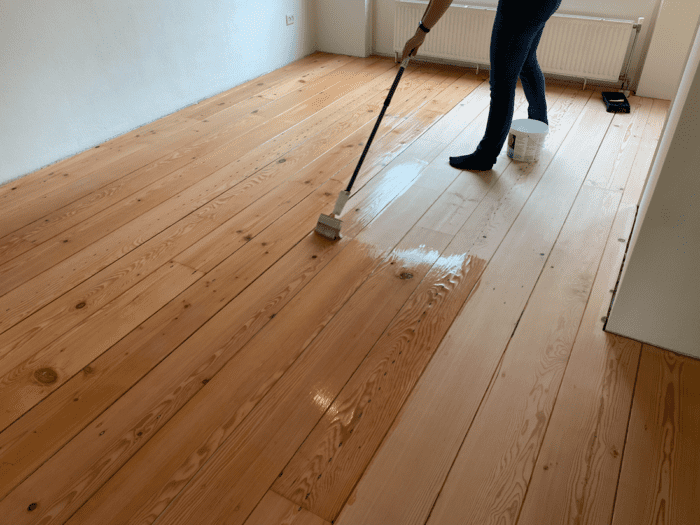
Want to varnish your floor?
Why is Topp such a great floor lacquer?
Topp is a matt floor lacquer that gives your wooden (parquet) floor a hard surface layer, while the appearance remains almost totally matt. A modern, ecological quality product. The lacquer smells pleasant and is easy to use, even if you are not a professional. Anyone can do it.
- Fully abrasion-resistant, with a long-lasting result (10-15 years)
- Beautiful matt appearance (gloss level approx. 8)
- Waterborne and low-solvent
- Easy and safe to use, also for the do-it-yourselfer
- Practical and affordable
It is also possible to also use Topp as a finish for floors painted with Moose Färg paint.
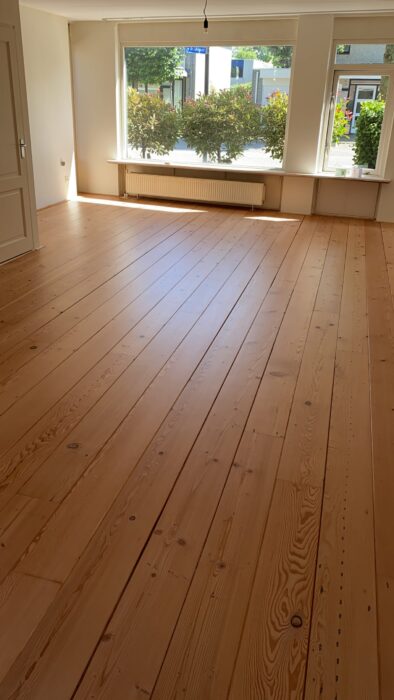
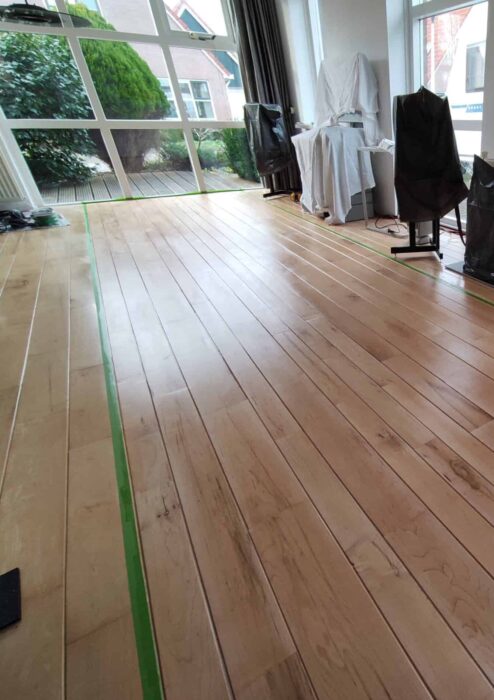
Step-by-step plan for wooden floor varnishing:
Varnishing a floor with our matt floor lacquer is not difficult. Most of the work is in the preparation of the wood. And, of course, it is a little inconvenient to wait for the varnish to dry when you live in your home at the same time. But, patience is key for the strongest result in the long term. Below are tips for a great, hard-wearing matt floor.
- Pre-processing
The most important thing when varnishing a floor is a good preparation of the wood. Often, a floor has already been varnished before. In this case, you will need to sand down the old varnish layer completely. This means that you first have to sand very coarsely to “break” the lacquer and then again with a finer grit to give the floor boards a nice and smooth surface again.
Tip: Start with a coarse grit (e.g. 40 or 60) and then start working with a lighter grit (80 or 120). The standard rule is to take a maximum doubling of grit the second time to get a nice, smooth sanded floor. If you want to sand even finer, you should be sanding 3 times. Ideally, sand the floor for about 0,8 mm.
Please be aware that a lacquer works like a magnifying glass: not only the charming wood grain, but also dirt and stains on a floor will be more visible after applying a lacquer. After varnishing, it is no longer possible to remove any dirt or dust. So, please make sure that your floor is completely free of dust and dirt before applying Topp.
Always check the adhesion on a small test piece beforehand. - Application
You can apply the lacquer directly to wood, but it is also suitable to use as a hard-wearing top layer on a floor that has been painted with Moose Färg paint.
Mix well before you get started! If Topp has been stored for a longer time, certain components can ‘sink’ causing the emulsion to be uneven. Pour the entire container of lacquer in one go and mix well or shake well before use.
You can apply Topp very easily with roller or brush. The lacquer does not smell and is completely safe in an indoor space – although we do recommend to ventilate to speed up drying time. The ideal drying temperature is at +20 °C.
The lacquer ‘spreads’ easily. You do need to apply it neatly and somewhat evenly, but brush marks will eventually disappear. Apply 1 – 3 coats (see below).
Before applying the final layer of Topp, you can sand very lightly with 100 -120 grit paper. Remove the sanding dust. Then, apply a final coat of lacquer to your floor. This improves the adhesion of the finishing coat. - Consumption
Depending on the application, apply 1 – 3 coats of Topp. 1 layer of Topp is sufficient for a decorative table or cabinet shelf.
For a surface that is used more intensively, such as a (bedroom) room floor, 2 layers are recommended. For a very intensively used surface, such as a kitchen floor or stairs, 3 layers of Topp are recommended.
With 1 litre of Topp, you can varnish approximately 7 – 10 m² (1 layer). On untreated wood, the first coat will require a bit more, but the next coats will require less. - Drying time
Drying time depends on temperature and humidity. Opening a window helps to speed up drying time: ventilation helps to reduce humidity. At temperatures above 15 degrees, you can apply the second layer after 24 hours (enter with socks).
After the last coat, you can carefully walk on the floor with socks after 24 hours. Furniture can usually be (re)placed after a week. Light furniture can be placed after 48 hours, but wait 4 days for heavier furniture or carpets. Be very careful when using the surface during the first four weeks (furniture sliding etc.). - Maintenance
Once dried completely, Topp is a particularly strong product that can take a beating. Its wear resistance is particularly good, so that after use you will have a beautiful, practical floor for many years. Major maintenance is not required.
Cleaning is of course possible: Topp is resistant to all common household cleaning products and detergents. Our linseed oil soap is also very suitable for cleaning varnished floors.
Moreover, regular vacuuming is good for the durability of your floor. Sand and gravel are the biggest causes of wear and tear on a wooden floor.
Technical specifications floor varnish Topp
| Application temperature | Above 18 °C (recommended humidity: 55-65%) |
| Consumption | Approx. 7 – 10 m² per litre (1 coat) |
| Suitable for use | Indoor |
| Gloss level | 8-10 (matt) |
| Apply | With brush or roller |
| Ready to use | Yes, but shake very well before use |
| Drying time (at 20 °C and sufficient ventilation) | Repaintable after 8 – 24 hours, ready to use after 1 week |
| Recommended number of layers | 2 |
| Cleaning | Brushes and work tools with water and a bit of mild soap |
| Shelf life | Up to 1 year after purchase |
| Store | In a dry and frost-free place (10 – 25 ºC) |
Order floor lacquer Topp easily in our webshop:
Painting a floor and finish with Topp
It also an option to first paint your floor with Moose F (opaque colour) or Dimma (semi-transparent). After painting, let dry thoroughly and finish with Topp for a hard-wearing top coat.
Good to know: painting and varnishing a floor is not a good combination when you have an oak wooden floor. This type of wood contains a lot of tannin. The tannin can seep through the paint layer, resulting in brown or yellow stains on your floor. With e.g. black or dark grey paint, this effect is not visible. But, with lighter colours such as white or light grey it is visible.
This seeping-through can also happen when your floor has large knots. A workaround is to varnish the knots first, then apply the paint colour and then varnish again. Ask for advice on this and in such cases always make a test piece first to see the effect on your own wood.
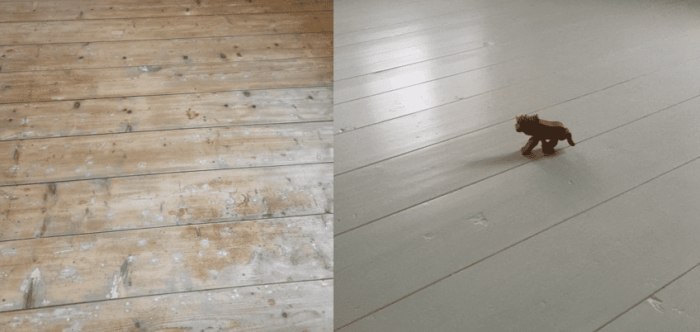
White wash floor
In recent years, a white wash floor has become very popular. And we understand why: with a white wash you cover up any discolouration (yellowing) of the wood. If the wooden floor is several years old an especially if it has been left in the sun, the boards will discolour into a yellowish tone. Not everyone likes this and with a white wash, the floor retains its light appearance.
There are two different ways to create a whitewash a floor:
- In addition to our transparent Topp varnish, is also possible to order Topp Vit. Top Vit is varnish with an addition of white pigment. When applied, it immediately creates a white haze on top of your wood. After using a layer of Top Vit, you should varnish with the regular Topp transparent. An advantage of this method is that it’s a quick way to create a white wash effect on your floor. A disadvantage is that it is quite difficult to influence the dosage of the white pigment: after curing Topp Vit, you can no longer distribute the pigments.
- The second option is to paint your floor with Dimma vit (white wash paint) first. After painting, you finish with wooden floor varnish Topp. The advantage here is that Dimma is very easy to apply. Also, if you’re not completely satisfied with the appearance – for example because the pigments have not been applied evenly – you can easily wipe or sand the paint layer to create the desired result. When you are satisfied with the result, varnish with Topp to make the floor wear-resistant. Extra advantage: if the lacquer damages, it will not show in the painted layer. The white wash floor keeps it’s appearance, even if the lacquer starts to wear over time.
Please note: whitewashing an oak floor is not a good idea. The tannins in oak seep through the paint layer after varnishing. This results in a stained effect. If you want to give it a try, make sure to make a test piece first and contact us for advice.
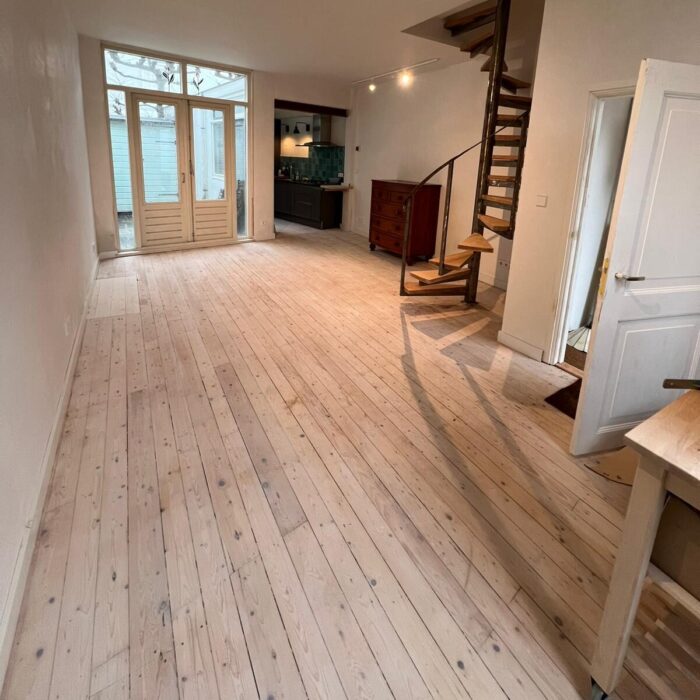
Frequently asked questions about varnishing a wooden floor
After varnishing your floor with Topp floor lacquer, you can walk on it (with socks!) after 24 hours. For heavier objects and carpets, the lacquer should harden for about four days. Usually, the lacquer is really well-hardened after a week, with adequate ventilation and at 20 degrees.
Yes, sanding is an essential step for the most beautiful result. Floor varnish works like a magnifying glass: everything becomes more visible. The beautiful wood structures become extra visible, but so do imperfections in the wood. Smooth sanding ensures a nicer result. After the first coat, sand lightly with sandpaper to smooth out wood fibres.
Topp is a particularly strong product that can take a beating. It’s wear-resistance, so you will have a beautiful, practical floor for many years after applying. In general, you will be maintenance-free for about 10 – 15 years.
Of course, this also depends on the intensity of use. If you have pets or often drag around furniture, it might wear a bit faster. Regular vacuuming ensures that the floor will last longer, as sand and gravel are the biggest cause of wear and tear. The wood type itself also has a lot of influence on the durability of the result. Hardwood is much sturdier than a soft wood type such as pine. The lacquer works just as well, but dents are more likely to appear in softer wood types.
Yes, you can and it creates a truly beautiful effect. Dimma white wash is perfect for painting your floor semi-transparent. After painting, finish with Topp.
Yes, you can. Parquet is a collective term for many types of wooden floors. Wooden floors can consist either out of several layers of wood or out of solid wood. Floor lacquer Topp is suitable for all types of wood, including parquet. If your floor is already varnished, please ask advice first.
For verandas or other horizontal exterior wood, we recommend using Pansar. This water-repellent coating prevents the penetration of water and prevents fungi and algae. It also prevents warping of the wood, which often happens when moisture soaks into the wood. Topp is only recommended for usage indoors.
No, you cannot varnish an oiled wooden floor. Oil is oil-based and our lacquer is water-based. A water-based lacquer will not work on a greasy surface because oil and water repel each other. It is possible to paint first with a water-based paint (such as Moose F) and then varnish.
With a wooden floor, the consideration is often whether to treat it with hard wax, wood oil or lacquer. While both can be beautiful, varnishing a floor has a few key advantages. A lacquered floor is a lot more easy to maintain than an oiled or waxed floor. Cleaning is easy with a mop and hoover, no special tools or products are needed. A lacquered floor is also more resistant to grease stains and liquid dirt. Moreover, varnishing a floor only needs to be done every 10 – 15 years, whereas an oiled floor often needs to be treated annually.
Would you like additional, personal advice?
We are happy to help. Send an e-mail or call +31(0) 6 55 333 165. Watch our Instruction Video for more information. Apply here for a free color-card.


